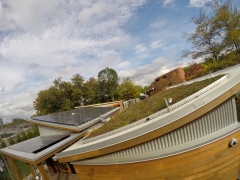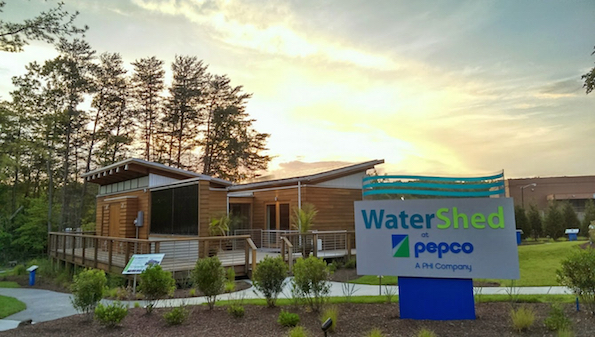Knauss legislative fellowships in Congress help build careers — and they're fun and educational. See our video and fact sheet for details.
The Maryland Sea Grant Bookstore will be closed for the winter holidays from Monday, December 15th to Friday, January 2nd and will not be taking orders during that time.
Ecology Meets Design: Green Roofs and Sustainable Communities
My senior year as a biology undergraduate at Drexel University was marked by the opening of the new Papadakis Integrated Sciences Building. At its center stands a 22-foot wide, 80-foot tall biowall. It is a beautiful and symbiotic array of tropical plants and microbes that naturally purify the air. I didn’t know it then, but it was my first exposure to ecologically engineered systems. These merge ecology and design to create technologies that make use of the natural abilities and functions of ecosystems, like plants, to provide benefits, such as improved air quality, to human society and the natural environment.
The biowall sparked my passion for studying how the benefits of ecologically engineered systems – like green rooftops -- can be used to improve urban sustainability. Urban sustainability is important as many of us live in and around coastal cities, which makes us disproportionately more at risk to the effects of climate change, such as flooding and an increase in the frequency and intensity of severe storms.
The looming threat of climate change is worrisome considering the fact that we have drastically altered coastal ecosystems with human developments, resulting in the loss of vegetation which played an important role in providing ecosystem services such as air purification and managing the flow of water throughout the atmosphere. As a result, we have traditionally relied on technologies designed by human to provide these lost benefits. We utilize HVAC systems to purify our air, or we design elaborate underground infrastructure to manage the flow of stormwater during intense storms.
However, these technologies rely on the same fossil fuels that contribute to climate change, and the technologies are prone to failure. In many cities, for example, our stormwater and sewage are combined and transported via underground pipes to energy-intensive wastewater treatment plants. As a result, when large storms occur, we often experience drastic flooding as our stormwater infrastructure gets clogged and backs up. Stormwater combined with untreated sewage is then emitted into major water bodies like the Chesapeake Bay.
I am part of a generation of researchers examining whether ecologically engineered technologies are the key to creating sustainable and resilient communities in the face of climate change. One of the systems I study are green roofs. They are vegetated systems placed on rooftops that are thought to provide a variety of benefits such as removing pollutants from air and water, making buildings cooler, and reducing the amount of stormwater clogging our infrastructure. Furthermore, they are often aesthetically beautiful in design while serving as habitats for birds and insects. They range in design from shallow lawn-like systems like the one I study to intensive and elaborate rooftop gardens.
However, scientists agree there is much to learn about these systems, particularly as they are increasingly being integrated in residential homes. My research group is working to evaluate their performance, sustainability, and how they function over time in a changing environment. Using high-resolution sensors, I am studying the energy savings potential and stormwater retention of the green roof on WaterShed, which is the 2011 winning sustainable home designed and built by researchers and students at the University of Maryland for the U.S. Solar Decathlon competition. We have water content sensors that allow us to study the amount of stormwater retained during rain events and temperature sensors that allow us to examine green roof cooling. We also have a weather station on site. This data is automatically collected and transmitted wirelessly to my computer, where I can analyze, for example, the effect of storm characteristics (size, intensity, frequency) on retention.
I am integrating this data into a model that allows me to predict green roof benefits and predict their sustainability and resilience using various metrics. It is my hope that my work not only provides crucial information on the performance of these systems but can also be used as a decision-making tool for coastal urban communities.
Since winning the 2011 U.S. Department of Energy Solar Decathlon competition, WaterShed was acquired by one of Maryland’s regional energy companies, Pepco Holdings, Inc. It is now permanently housed within their facility in Rockville, Maryland, where it serves as the centerpiece of the Pepco WaterShed Sustainability Center to advance educational, outreach, and research goals. Feel free to come by and take a tour!
Photo, top: This is the shallow, extensive green roof that I am studying. The green roof has several energy and water sensors that allow us to study the roof's cooling and stormwater retention properties. Credit: Scott Tjaden
See all posts to the Fellowship Experiences blog





